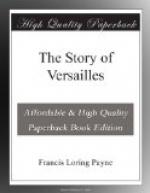The ceremony of tasting the King’s wine was most impressive, and it was regarded as a necessary and effective safeguard against poisonous attacks or deleterious effects on His Majesty’s august health. The thought is suggested, however, that the test could have been effective only in case of immediate or quick-working poison. A slow and insidious drug—and there were experts in such concoctions in those days—would surely have passed the taster’s test and affected the King in time. The test was but a mere formality, however, for Louis was the Most Adored Monarch. As one chronicler has observed, “He was not only majestic, he was amiable. Those that surrounded him, the members of his family, his ministers, his domestics, loved him.” Poison played no part in his career. That subtle method of attack was reserved for Louis XVI and Marie Antoinette, on both of whom it was attempted more than once.
The carver, having taken his place before the table of the King, presented and uncovered all the dishes, and when His Majesty told him to do so, or made him a sign, he removed them, handing them to the plate-changer or to his assistants. He changed the King’s plate and napkin from time to time, and cut the meats when the King did not cut them himself.
On rare occasions, when the King was in residence at Versailles, his brother dined with him. But large, formal dinners were rare, and women were seldom at the King’s table except on grand occasions.
Upon leaving the table, Saint-Simon tells us, “the King immediately entered his cabinet. That was the time for distinguished people to speak to him. He stopped at the door a moment to listen, then entered; very rarely did any one follow him, never without asking permission to do so; and for this few had the courage. . . . The King amused himself by feeding his dogs, and remained with them more or less time, then asked for his wardrobe, changed before the very few distinguished people it pleased the first gentleman of the Chamber to admit there, and immediately went out by the back stairs into the court of marble to get the air. . . . He went out for three objects: stag-hunting, once or more each week; shooting in his parks (and no man handled a gun with more grace or skill), once or twice each week; and walking in his gardens, and to see his workmen.”




